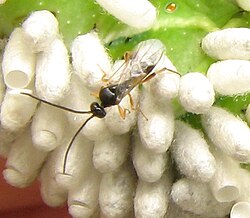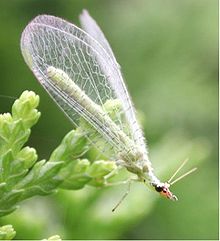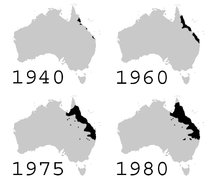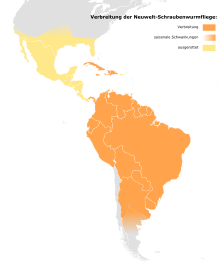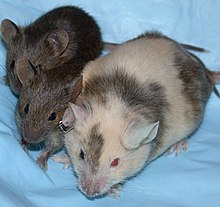From Wikipedia, the free encyclopedia
A parasitoid wasp (Cotesia congregata) adult with pupal cocoons on its host, a tobacco hornworm (Manduca sexta, green background), an example of a hymenopteran biological control agent
Biological control or biocontrol is a method of controlling pests such as insects, mites, weeds and plant diseases using other organisms. It relies on predation, parasitism, herbivory, or other natural mechanisms, but typically also involves an active human management role. It can be an important component of integrated pest management (IPM) programs.
There are three basic strategies for biological pest control:
classical (importation), where a natural enemy of a pest is introduced
in the hope of achieving control; inductive (augmentation), in which a
large population of natural enemies are administered for quick pest
control; and inoculative (conservation), in which measures are taken to
maintain natural enemies through regular reestablishment.
Natural enemies of insect pests, also known as biological control agents, include predators, parasitoids, pathogens, and competitors.
Biological control agents of plant diseases are most often referred to
as antagonists. Biological control agents of weeds include seed
predators, herbivores and plant pathogens.
Biological control can have side-effects on biodiversity
through attacks on non-target species by any of the same mechanisms,
especially when a species is introduced without thorough understanding
of the possible consequences.
History
The term "biological control" was first used by Harry Scott Smith at the 1919 meeting of the Pacific Slope Branch of the American Association of Economic Entomologists, in Riverside, California.
It was brought into more widespread use by the entomologist Paul H.
DeBach (1914–1993) who worked on citrus crop pests throughout his life.
However, the practice has previously been used for centuries. The first
report of the use of an insect species to control an insect pest comes
from "Nanfang Caomu Zhuang" (南方草木狀 Plants of the Southern Regions) (c. 304 AD), attributed to Western Jin dynasty botanist Ji Han (嵇含, 263–307), in which it is mentioned that "Jiaozhi
people sell ants and their nests attached to twigs looking like thin
cotton envelopes, the reddish-yellow ant being larger than normal.
Without such ants, southern citrus fruits will be severely
insect-damaged". The ants used are known as huang gan (huang = yellow, gan = citrus) ants (Oecophylla smaragdina). The practice was later reported by Ling Biao Lu Yi (late Tang Dynasty or Early Five Dynasties), in Ji Le Pian by Zhuang Jisu (Southern Song Dynasty), in the Book of Tree Planting by Yu Zhen Mu (Ming Dynasty), in the book Guangdong Xing Yu (17th century), Lingnan by Wu Zhen Fang (Qing Dynasty), in Nanyue Miscellanies by Li Diao Yuan, and others.
Biological control techniques as we know them today started to
emerge in the 1870s. During this decade, in the US, the Missouri State
Entomologist C. V. Riley and the Illinois State Entomologist W. LeBaron
began within-state redistribution of parasitoids to control crop pests.
The first international shipment of an insect as biological control
agent was made by Charles V. Riley in 1873, shipping to France the
predatory mites Tyroglyphus phylloxera to help fight the grapevine phylloxera (Daktulosphaira vitifoliae) that was destroying grapevines in France. The United States Department of Agriculture
(USDA) initiated research in classical biological control following the
establishment of the Division of Entomology in 1881, with C. V. Riley
as Chief. The first importation of a parasitoidal wasp into the United
States was that of the braconid Cotesia glomerata in 1883–1884, imported from Europe to control the invasive cabbage white butterfly, Pieris rapae. In 1888–1889 the vedalia beetle, Rodolia cardinalis, a lady beetle, was introduced from Australia to California to control the cottony cushion scale, Icerya purchasi.
This had become a major problem for the newly developed citrus industry
in California, but by the end of 1889 the cottony cushion scale
population had already declined. This great success led to further
introductions of beneficial insects into the US.
In 1905 the USDA initiated its first large-scale biological
control program, sending entomologists to Europe and Japan to look for
natural enemies of the gypsy moth, Lymantria dispar dispar, and brown-tail moth, Euproctis chrysorrhoea,
invasive pests of trees and shrubs. As a result, nine parasitoids
(solitary wasps) of gypsy moth, seven of brown-tail moth, and two
predators of both moths became established in the US. Although the gypsy
moth was not fully controlled by these natural enemies, the frequency,
duration, and severity of its outbreaks were reduced and the program was
regarded as successful. This program also led to the development of
many concepts, principles, and procedures for the implementation of
biological control programs.
Cactoblastis cactorum larvae feeding on Opuntia prickly pear cacti
Prickly pear cacti
were introduced into Queensland, Australia as ornamental plants,
starting in 1788. They quickly spread to cover over 25 million hectares
of Australia by 1920, increasing by 1 million hectares per year.
Digging, burning and crushing all proved ineffective. Two control agents
were introduced to help control the spread of the plant, the cactus
moth Cactoblastis cactorum, and the scale insect Dactylopius.
Between 1926 and 1931, tens of millions of cactus moth eggs were
distributed around Queensland with great success, and by 1932, most
areas of prickly pear had been destroyed.
The first reported case of a classical biological control attempt in Canada involves the parasitoidal wasp Trichogramma minutum.
Individuals were caught in New York State and released in Ontario
gardens in 1882 by William Saunders, trained chemist and first Director
of the Dominion Experimental Farms, for controlling the invasive
currantworm Nematus ribesii.
Between 1884 and 1908, the first Dominion Entomologist, James Fletcher,
continued introductions of other parasitoids and pathogens for the
control of pests in Canada.
Types of biological pest control
There
are three basic biological pest control strategies: importation
(classical biological control), augmentation and conservation.
Importation
Rodolia cardinalis, the vedalia beetle, was imported from Australia to California in the 19th century, successfully controlling cottony cushion scale.
Importation or classical biological control involves the introduction
of a pest's natural enemies to a new locale where they do not occur
naturally. Early instances were often unofficial and not based on
research, and some introduced species became serious pests themselves.
To be most effective at controlling a pest, a biological control
agent requires a colonizing ability which allows it to keep pace with
changes to the habitat in space and time. Control is greatest if the
agent has temporal persistence, so that it can maintain its population
even in the temporary absence of the target species, and if it is an
opportunistic forager, enabling it to rapidly exploit a pest population.
One of the earliest successes was in controlling Icerya purchasi (cottony cushion scale) in Australia, using a predatory insect Rodolia cardinalis (the vedalia beetle). This success was repeated in California using the beetle and a parasitoidal fly, Cryptochaetum iceryae. Other successful cases include the control of Antonina graminis in Texas by Neodusmetia sangwani in the 1960s.
Damage from Hypera postica,
the alfalfa weevil, a serious introduced pest of forage, was
substantially reduced by the introduction of natural enemies. 20 years
after their introduction the population of weevils in the alfalfa area treated for alfalfa weevil in the Northeastern United States remained 75 percent down.
The invasive species Alternanthera philoxeroides (alligator weed) was controlled in Florida (U.S.) by introducing alligator weed flea beetle.
Alligator weed was introduced to the United States from South America. It takes root in shallow water, interfering with navigation, irrigation, and flood control. The alligator weed flea beetle and two other biological controls were released in Florida, greatly reducing the amount of land covered by the plant. Another aquatic weed, the giant salvinia (Salvinia molesta) is a serious pest, covering waterways, reducing water flow and harming native species. Control with the salvinia weevil (Cyrtobagous salviniae) and the salvinia stem-borer moth (Samea multiplicalis) is effective in warm climates, and in Zimbabwe, a 99% control of the weed was obtained over a two-year period.
Small commercially reared parasitoidal wasps, Trichogramma ostriniae, provide limited and erratic control of the European corn borer (Ostrinia nubilalis), a serious pest. Careful formulations of the bacterium Bacillus thuringiensis are more effective.
The population of Levuana iridescens, the Levuana moth, a serious coconut pest in Fiji, was brought under control by a classical biological control program in the 1920s.
Augmentation
Hippodamia convergens, the convergent lady beetle, is commonly sold for biological control of aphids.
Augmentation involves the supplemental release of natural enemies
that occur in a particular area, boosting the naturally occurring
populations there. In inoculative release, small numbers of the control
agents are released at intervals to allow them to reproduce, in the hope
of setting up longer-term control, and thus keeping the pest down to a
low level, constituting prevention rather than cure. In inundative
release, in contrast, large numbers are released in the hope of rapidly
reducing a damaging pest population, correcting a problem that has
already arisen. Augmentation can be effective, but is not guaranteed to
work, and depends on the precise details of the interactions between
each pest and control agent.
An example of inoculative release occurs in the horticultural production of several crops in greenhouses. Periodic releases of the parasitoidal wasp, Encarsia formosa, are used to control greenhouse whitefly, while the predatory mite Phytoseiulus persimilis is used for control of the two-spotted spider mite.
The egg parasite Trichogramma is frequently released inundatively to control harmful moths. Similarly, Bacillus thuringiensis and other microbial insecticides are used in large enough quantities for a rapid effect. Recommended release rates for Trichogramma
in vegetable or field crops range from 5,000 to 200,000 per acre (1 to
50 per square metre) per week according to the level of pest
infestation. Similarly, nematodes
that kill insects (that are entomopathogenic) are released at rates of
millions and even billions per acre for control of certain soil-dwelling
insect pests.
Conservation
The conservation of existing natural enemies in an environment is the third method of biological pest control.
Natural enemies are already adapted to the habitat
and to the target pest, and their conservation can be simple and
cost-effective, as when nectar-producing crop plants are grown in the
borders of rice fields. These provide nectar to support parasitoids and
predators of planthopper pests and have been demonstrated to be so
effective (reducing pest densities by 10- or even 100-fold) that farmers
sprayed 70% less insecticides and enjoyed yields boosted by 5%.
Predators of aphids were similarly found to be present in tussock
grasses by field boundary hedges in England, but they spread too slowly
to reach the centres of fields. Control was improved by planting a
metre-wide strip of tussock grasses in field centres, enabling aphid
predators to overwinter there.
An inverted flowerpot filled with straw to attract earwigs
Cropping systems can be modified to favor natural enemies, a practice
sometimes referred to as habitat manipulation. Providing a suitable
habitat, such as a shelterbelt, hedgerow, or beetle bank
where beneficial insects such as parasitoidal wasps can live and
reproduce, can help ensure the survival of populations of natural
enemies. Things as simple as leaving a layer of fallen leaves or mulch
in place provides a suitable food source for worms and provides a
shelter for insects, in turn being a food source for such beneficial
mammals as hedgehogs and shrews. Compost piles and stacks of wood can provide shelter for invertebrates and small mammals. Long grass and ponds
support amphibians. Not removing dead annuals and non-hardy plants in
the autumn allows insects to make use of their hollow stems during
winter.
In California, prune trees are sometimes planted in grape vineyards to
provide an improved overwintering habitat or refuge for a key grape pest
parasitoid. The providing of artificial shelters in the form of wooden caskets, boxes or flowerpots is also sometimes undertaken, particularly in gardens, to make a cropped area more attractive to natural enemies. For example, earwigs are natural predators which can be encouraged in gardens by hanging upside-down flowerpots filled with straw or wood wool. Green lacewings
can be encouraged by using plastic bottles with an open bottom and a
roll of cardboard inside. Birdhouses enable insectivorous birds to nest;
the most useful birds can be attracted by choosing an opening just
large enough for the desired species.
In cotton production, the replacement of broad-spectrum insecticides with selective control measures such as Bt cotton
can create a more favorable environment for natural enemies of cotton
pests due to reduced insecticide exposure risk. Such predators or parasitoids can control pests not affected by the Bt protein.
Reduced prey quality and abundance associated increased control from Bt
cotton can also indirectly decrease natural enemy populations in some
cases, but the percentage of pests eaten or parasitized in Bt and non-Bt
cotton are often similar.
Biological control agents
Predators
Predators are mainly free-living species that directly consume a large number of prey
during their whole lifetime. Given that many major crop pests are
insects, many of the predators used in biological control are
insectivorous species. Lady beetles, and in particular their larvae which are active between May and July in the northern hemisphere, are voracious predators of aphids, and also consume mites, scale insects and small caterpillars. The spotted lady beetle (Coleomegilla maculata) is also able to feed on the eggs and larvae of the Colorado potato beetle (Leptinotarsa decemlineata).
The larvae of many hoverfly species principally feed upon aphids, one larva devouring up to 400 in its lifetime. Their effectiveness in commercial crops has not been studied.
Several species of entomopathogenic nematode are important predators of insect and other invertebrate pests.
Entomopathogenic nematodes form a stress–resistant stage known as the
infective juvenile. These spread in the soil and infect suitable insect
hosts. Upon entering the insect they move to the hemolymph where they recover from their stagnated state of development and release their bacterial symbionts. The bacterial symbionts reproduce and release toxins, which then kill the host insect. Phasmarhabditis hermaphrodita is a microscopic nematode
that kills slugs. Its complex life cycle includes a free-living,
infective stage in the soil where it becomes associated with a
pathogenic bacteria such as Moraxella osloensis.
The nematode enters the slug through the posterior mantle region,
thereafter feeding and reproducing inside, but it is the bacteria that
kill the slug. The nematode is available commercially in Europe and is
applied by watering onto moist soil. Entomopathogenic nematodes have a limited shelf life because of their limited resistance to high temperature and dry conditions. The type of soil they are applied to may also limit their effectiveness.
Species used to control spider mites include the predatory mites Phytoseiulus persimilis, Neoseilus californicus, and Amblyseius cucumeris, the predatory midge Feltiella acarisuga, and a ladybird Stethorus punctillum. The bug Orius insidiosus has been successfully used against the two-spotted spider mite and the western flower thrips (Frankliniella occidentalis).
Predators including Cactoblastis cactorum (mentioned above) can also be used to destroy invasive plant species. As another example, the poison hemlock moth (Agonopterix alstroemeriana) can be used to control poison hemlock (Conium maculatum).
During its larval stage, the moth strictly consumes its host plant,
poison hemlock, and can exist at hundreds of larvae per individual host
plant, destroying large swathes of the hemlock.
The parasitoid wasp Aleiodes indiscretus parasitizing a gypsy moth caterpillar, a serious pest of forestry
For rodent pests, cats are effective biological control when used in conjunction with reduction of "harborage"/hiding locations. While cats are effective at preventing rodent "population explosions", they are not effective for eliminating pre-existing severe infestations. Barn owls are also sometimes used as biological rodent control. Although there are no quantitative studies of the effectiveness of barn owls for this purpose, they are known rodent predators that can be used in addition to or instead of cats; they can be encouraged into an area with nest boxes.
In Honduras, where the mosquito Aedes aegypti was transmitting dengue fever and other infectious diseases, biological control was attempted by a community action plan; copepods, baby turtles, and juvenile tilapia were added to the wells and tanks where the mosquito breeds, and the mosquito larvae were eliminated.
Parasitoids
Parasitoids lay their eggs on or in the body of an insect host, which
is then used as a food for developing larvae. The host is ultimately
killed. Most insect parasitoids are wasps or flies, and many have a very narrow host range. The most important groups are the ichneumonid wasps, which mainly use caterpillars as hosts; braconid wasps, which attack caterpillars and a wide range of other insects including aphids; chalcid wasps, which parasitize eggs and larvae of many insect species; and tachinid flies, which parasitize a wide range of insects including caterpillars, beetle adults and larvae, and true bugs. Parasitoids are most effective at reducing pest populations when their host organisms have limited refuges to hide from them.
Encarsia formosa, widely used in greenhouse horticulture, was one of the first biological control agents developed.
Life cycles of greenhouse whitefly and its parasitoid wasp Encarsia formosa
Parasitoids are among the most widely used biological control agents.
Commercially, there are two types of rearing systems: short-term daily
output with high production of parasitoids per day, and long-term, low
daily output systems.
In most instances, production will need to be matched with the
appropriate release dates when susceptible host species at a suitable
phase of development will be available.
Larger production facilities produce on a yearlong basis, whereas some
facilities produce only seasonally. Rearing facilities are usually a
significant distance from where the agents are to be used in the field,
and transporting the parasitoids from the point of production to the
point of use can pose problems. Shipping conditions can be too hot, and even vibrations from planes or trucks can adversely affect parasitoids.
Encarsia formosa is a small predatory chalcid wasp which is a parasitoid of whitefly, a sap-feeding insect which can cause wilting and black sooty moulds
in glasshouse vegetable and ornamental crops. It is most effective when
dealing with low level infestations, giving protection over a long
period of time. The wasp lays its eggs in young whitefly 'scales',
turning them black as the parasite larvae pupate. Gonatocerus ashmeadi (Hymenoptera: Mymaridae) has been introduced to control the glassy-winged sharpshooter Homalodisca vitripennis (Hemiptera: Cicadellidae) in French Polynesia and has successfully controlled ~95% of the pest density.
The eastern spruce budworm is an example of a destructive insect in fir and spruce forests. Birds are a natural form of biological control, but the Trichogramma minutum, a species of parasitic wasp, has been investigated as an alternative to more controversial chemical controls.
There are a number of recent studies pursuing sustainable methods for controlling urban cockroaches using parasitic wasps.
Since most cockroaches remain in the sewer system and sheltered areas
which are inaccessible to insecticides, employing active-hunter wasps is
a strategy to try and reduce their populations.
Pathogens
Pathogenic micro-organisms include bacteria, fungi, and viruses. They kill or debilitate their host and are relatively host-specific. Various microbial insect diseases occur naturally, but may also be used as biological pesticides.
When naturally occurring, these outbreaks are density-dependent in that
they generally only occur as insect populations become denser.
Bacteria
Bacteria
used for biological control infect insects via their digestive tracts,
so they offer only limited options for controlling insects with sucking
mouth parts such as aphids and scale insects. Bacillus thuringiensis,
a soil-dwelling bacterium, is the most widely applied species of
bacteria used for biological control, with at least four sub-species
used against Lepidopteran (moth, butterfly), Coleopteran (beetle) and Dipteran
(true fly) insect pests. The bacterium is available to organic farmers
in sachets of dried spores which are mixed with water and sprayed onto
vulnerable plants such as brassicas and fruit trees. Genes from B. thuringiensis have also been incorporated into transgenic crops, making the plants express some of the bacterium's toxins, which are proteins. These confer resistance to insect pests and thus reduce the necessity for pesticide use. If pests develop resistance to the toxins in these crops, B. thuringiensis will become useless in organic farming also.
The bacterium Paenibacillus popilliae which causes milky spore disease has been found useful in the control of Japanese beetle, killing the larvae. It is very specific to its host species and is harmless to vertebrates and other invertebrates.
Fungi
Green peach aphid, a pest in its own right and a vector of plant viruses, killed by the fungus Pandora neoaphidis (Zygomycota: Entomophthorales) Scale bar = 0.3 mm.
Entomopathogenic fungi, which cause disease in insects, include at least 14 species that attack aphids. Beauveria bassiana is mass-produced and used to manage a wide variety of insect pests including whiteflies, thrips, aphids and weevils. Lecanicillium spp. are deployed against white flies, thrips and aphids. Metarhizium spp. are used against pests including beetles, locusts and other grasshoppers, Hemiptera, and spider mites. Paecilomyces fumosoroseus is effective against white flies, thrips and aphids; Purpureocillium lilacinus is used against root-knot nematodes, and 89 Trichoderma species against certain plant pathogens. Trichoderma viride has been used against Dutch elm disease, and has shown some effect in suppressing silver leaf, a disease of stone fruits caused by the pathogenic fungus Chondrostereum purpureum.
The fungi Cordyceps and Metacordyceps are deployed against a wide spectrum of arthropods. Entomophaga is effective against pests such as the green peach aphid.
Several members of Chytridiomycota and Blastocladiomycota have been explored as agents of biological control. From Chytridiomycota, Synchytrium solstitiale is being considered as a control agent of the yellow star thistle (Centaurea solstitialis) in the United States.
Viruses
Baculoviruses are specific to individual insect host species and have been shown to be useful in biological pest control. For example, the Lymantria dispar multicapsid nuclear polyhedrosis virus has been used to spray large areas of forest in North America where larvae of the gypsy moth
are causing serious defoliation. The moth larvae are killed by the
virus they have eaten and die, the disintegrating cadavers leaving virus
particles on the foliage to infect other larvae.
A mammalian virus, the rabbit haemorrhagic disease virus was introduced to Australia to attempt to control the European rabbit populations there.
It escaped from quarantine and spread across the country, killing large
numbers of rabbits. Very young animals survived, passing immunity to
their offspring in due course and eventually producing a virus-resistant
population.
Introduction into New Zealand in the 1990s was similarly successful at
first, but a decade later, immunity had developed and populations had
returned to pre-RHD levels.
Oomycota
Lagenidium giganteum
is a water-borne mold that parasitizes the larval stage of mosquitoes.
When applied to water, the motile spores avoid unsuitable host species
and search out suitable mosquito larval hosts. This mold has the
advantages of a dormant phase, resistant to desiccation, with
slow-release characteristics over several years. Unfortunately, it is
susceptible to many chemicals used in mosquito abatement programmes.
Competitors
The legume vine Mucuna pruriens is used in the countries of Benin and Vietnam as a biological control for problematic Imperata cylindrica grass: the vine is extremely vigorous and suppresses neighbouring plants by out-competing them for space and light. Mucuna pruriens is said not to be invasive outside its cultivated area. Desmodium uncinatum can be used in push-pull farming to stop the parasitic plant, witchweed (Striga).
The Australian bush fly, Musca vetustissima,
is a major nuisance pest in Australia, but native decomposers found in
Australia are not adapted to feeding on cow dung, which is where bush
flies breed. Therefore, the Australian Dung Beetle Project (1965–1985), led by George Bornemissza of the Commonwealth Scientific and Industrial Research Organisation, released forty-nine species of dung beetle, to reduce the amount of dung and therefore also the potential breeding sites of the fly.
Combined use of parasitoids and pathogens
In
cases of massive and severe infection of invasive pests, techniques of
pest control are often used in combination. An example is the emerald ash borer, Agrilus planipennis, an invasive beetle from China, which has destroyed tens of millions of ash trees in its introduced range in North America.
As part of the campaign against it, from 2003 American scientists and
the Chinese Academy of Forestry searched for its natural enemies in the
wild, leading to the discovery of several parasitoid wasps, namely Tetrastichus planipennisi, a gregarious larval endoparasitoid, Oobius agrili, a solitary, parthenogenic egg parasitoid, and Spathius agrili, a gregarious larval ectoparasitoid. These have been introduced and released into the United States of America as a possible biological control of the emerald ash borer. Initial results for Tetrastichus planipennisi have shown promise, and it is now being released along with Beauveria bassiana, a fungal pathogen with known insecticidal properties.
Difficulties
Many
of the most important pests are exotic, invasive species that severely
impact agriculture, horticulture, forestry and urban environments. They
tend to arrive without their co-evolved
parasites, pathogens and predators, and by escaping from these,
populations may soar. Importing the natural enemies of these pests may
seem a logical move but this may have unintended consequences;
regulations may be ineffective and there may be unanticipated effects
on biodiversity, and the adoption of the techniques may prove
challenging because of a lack of knowledge among farmers and growers.
Side effects
Biological control can affect biodiversity through predation, parasitism, pathogenicity, competition, or other attacks on non-target species. An introduced control does not always target only the intended pest species; it can also target native species.
In Hawaii during the 1940s parasitic wasps were introduced to control a
lepidopteran pest and the wasps are still found there today. This may
have a negative impact on the native ecosystem; however, host range and
impacts need to be studied before declaring their impact on the
environment.
Cane toad
(introduced into Australia 1935) spread from 1940 to 1980: it was
ineffective as a control agent. Its distribution has continued to widen
since 1980.
Vertebrate animals tend to be generalist feeders, and seldom make
good biological control agents; many of the classic cases of "biocontrol
gone awry" involve vertebrates. For example, the cane toad (Rhinella marina) was intentionally introduced to Australia to control the greyback cane beetle (Dermolepida albohirtum), and other pests of sugar cane. 102 toads were obtained from Hawaii
and bred in captivity to increase their numbers until they were
released into the sugar cane fields of the tropic north in 1935. It was
later discovered that the toads could not jump very high and so were
unable to eat the cane beetles which stayed on the upper stalks of the
cane plants. However, the toad thrived by feeding on other insects and
soon spread very rapidly; it took over native amphibian habitat and brought foreign disease to native toads and frogs, dramatically reducing their populations. Also, when it is threatened or handled, the cane toad releases poison from parotoid glands on its shoulders; native Australian species such as goannas, tiger snakes, dingos and northern quolls
that attempted to eat the toad were harmed or killed. However, there
has been some recent evidence that native predators are adapting, both
physiologically and through changing their behaviour, so in the long
run, their populations may recover.
Rhinocyllus conicus, a seed-feeding weevil, was introduced to North America to control exotic musk thistle (Carduus nutans) and Canadian thistle (Cirsium arvense). However, the weevil also attacks native thistles, harming such species as the endemic Platte thistle (Cirsium neomexicanum)
by selecting larger plants (which reduced the gene pool), reducing seed
production and ultimately threatening the species' survival. Similarly, the weevil Larinus planus was also used to try to control the Canadian thistle, but it damaged other thistles as well. This included one species classified as threatened.
The small Asian mongoose (Herpestus javanicus) was introduced to Hawaii in order to control the rat population. However, the mongoose was diurnal, and the rats emerged at night; the mongoose therefore preyed on the endemic birds of Hawaii, especially their eggs,
more often than it ate the rats, and now both rats and mongooses
threaten the birds. This introduction was undertaken without
understanding the consequences of such an action. No regulations existed
at the time, and more careful evaluation should prevent such releases
now.
The sturdy and prolific eastern mosquitofish (Gambusia holbrooki)
is a native of the southeastern United States and was introduced around
the world in the 1930s and '40s to feed on mosquito larvae and thus
combat malaria.
However, it has thrived at the expense of local species, causing a
decline of endemic fish and frogs through competition for food
resources, as well as through eating their eggs and larvae.
In Australia, control of the mosquitofish is the subject of discussion;
in 1989 researchers A. H. Arthington and L. L. Lloyd stated that
"biological population control is well beyond present capabilities".
Grower education
A
potential obstacle to the adoption of biological pest control measures
is that growers may prefer to stay with the familiar use of pesticides.
However, pesticides have undesired effects, including the development of
resistance among pests, and the destruction of natural enemies; these
may in turn enable outbreaks of pests of other species than the ones
originally targeted, and on crops at a distance from those treated with
pesticides.
One method of increasing grower adoption of biocontrol methods involves
letting them learn by doing, for example showing them simple field
experiments, enabling them to observe the live predation of pests, or
demonstrations of parasitised pests. In the Philippines, early season
sprays against leaf folder caterpillars were common practice, but
growers were asked to follow a 'rule of thumb' of not spraying against
leaf folders for the first 30 days after transplanting; participation in
this resulted in a reduction of insecticide use by 1/3 and a change in
grower perception of insecticide use.

